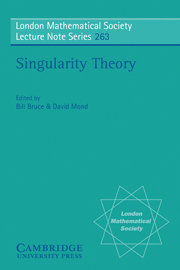 Singularity Theory
Singularity Theory Book contents
- Frontmatter
- Contents
- Preface
- Introduction
- Summaries of the Papers
- Complex Singularities
- Stratifications and Equisingularity Theory
- Global Singularity Theory
- Singularities of Mappings
- An Introduction to the Image Computing Spectral Sequence
- On the Classification and Geometry of Corank 1 Map-Germs from Three-Space to Four-Space
- Multiplicities of Zero-Schemes in Quasihomogeneous Corank-1 Singularities Cn → Cn
- Butterflies and Umbilics of Stable Perturbations of Analytic Map-Germs (C5, 0) → (C4, 0)
- Applications of Singularity Theory
- References
An Introduction to the Image Computing Spectral Sequence
Published online by Cambridge University Press: 05 May 2013
- Frontmatter
- Contents
- Preface
- Introduction
- Summaries of the Papers
- Complex Singularities
- Stratifications and Equisingularity Theory
- Global Singularity Theory
- Singularities of Mappings
- An Introduction to the Image Computing Spectral Sequence
- On the Classification and Geometry of Corank 1 Map-Germs from Three-Space to Four-Space
- Multiplicities of Zero-Schemes in Quasihomogeneous Corank-1 Singularities Cn → Cn
- Butterflies and Umbilics of Stable Perturbations of Analytic Map-Germs (C5, 0) → (C4, 0)
- Applications of Singularity Theory
- References
Summary
Introduction
The image computing spectral sequence is a powerful new tool in the analysis of the homology of the image of a finite map. In singularity theory it has been successful in the study of the local topology of images of finite complex analytic maps, see [3], [4], [10] and [21]; a good introduction to the topology of images is given in the survey paper [26]. However, the sequence is surely useful elsewhere, see [15], and it is the intention that this paper introduces the sequence to a wider audience.
As the name suggests the spectral sequence calculates the homology of the image of a finite and proper map. Much work has been done on the study of the topology of fibres of maps and this sequence allows us deep insights into the topology of images. The terms of the sequence are given by the alternating homology of the multiple point spaces of the map, and so Sections 2 and 3 are devoted to a description of these. The sequence is described in Section 4 and the next section gives numerous examples of the sequence in action. Section 6 deals with how to deduce homotopy information about the image using alternating homology. This section is followed by one on the local topology of images of finite complex analytic maps.
- Type
- Chapter
- Information
- Singularity TheoryProceedings of the European Singularities Conference, August 1996, Liverpool and Dedicated to C.T.C. Wall on the Occasion of his 60th Birthday, pp. 305 - 324Publisher: Cambridge University PressPrint publication year: 1999
- 4
- Cited by


